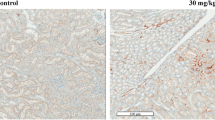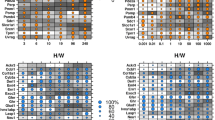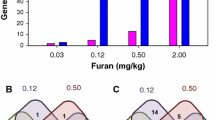Abstract
The effect of oxfendazole (OX), a benzimidazole anthelmintic, on hepatic gene expression was investigated in the liver of rats as a preliminary study to elucidate the possible mechanism of its non-genotoxic hepatocarcinogenesis. The liver from a male F344/N rat given a diet containing 500 ppm of OX for 3 weeks was examined by global gene expression analysis in comparison with an untreated rat. Microarray analysis revealed that phase I and phase II detoxifying enzymes were up-regulated in an OX-treated rat. In addition to these genes, the expressions of several upregulated genes related to xenobiotic metabolism and oxidative stress [e.g. Cyp1a1; NAD(P)H dehydrogenase, quinone 1 (Nqo1); glutathione peroxidase 2 (Gpx2); glutathione S-transferase Yc2 subunit (Yc2)], were confirmed by real-time reverse transcription polymerase chain reaction (RT-PCR). Furthermore, rats were administered 500 or 1,000 ppm of OX for 9 weeks, and the effect of OX on oxidative stress responses was evaluated by real-time RT-PCR along with conventional toxicological assays, including lipid peroxidation (thiobarbituric acid-reactive substance; TBARS). A longer treatment period and/or a higher dose of OX tended to increase the gene expressions of not only phase I (Cyp1a1 and Cyp1a2) but also phase II (Nqo1, Gpx2, Yc2, and Akr7a3) drug metabolizing enzymes. Toxicological parameters, such as TBARS, serum aspartate aminotransferase (AST), and serum alkaline phosphatase (ALP), showed slight but significant increases after treatment with OX for 9 weeks. These results indicate that OX elicits adaptive responses against oxidative stress in the liver and suggest that the imbalance in redox status might be one of the factors triggering the initial step of OX-induced non-genotoxic carcinogenesis in the liver of rats.


Similar content being viewed by others
References
Aix L, Rey-Grobellet X, Larrieu G, Lesca P, Galtier P (1994) Thiabendazole is an inducer of cytochrome P4501A1 in cultured rabbit hepatocytes. Biochem Biophys Res Commun 202:1483–1489
Aoki Y, Sato H, Nishimura N, Takahashi S, Itoh K, Yamamoto M (2001) Accelerated DNA adduct formation in the lung of the Nrf2 knockout mouse exposed to diesel exhaust. Toxicol Appl Pharmacol 173:154–160
Baliharova V, Skalova L, Maas RF, De Vrieze G, Bull S, Fink-Gremmels J (2003) The effects of benzimidazole anthelmintics on P4501A in rat hepatocytes and HepG2 cells. Res Vet Sci 75:61–69
Brigelius-Flohe R (1999) Tissue-specific functions of individual glutathione peroxidases. Free Radic Biol Med 27:951–965
Chu FF, Doroshow JH, Esworthy RS (1993) Expression, characterization, and tissue distribution of a new cellular selenium-dependent glutathione peroxidase, GSHPx-GI. J Biol Chem 268:2571–2576
Daujat M, Peryt B, Lesca P, Fourtanier G, Domergue J, Maurel P (1992) Omeprazole, an inducer of human CYP1A1 and 1A2, is not a ligand for the Ah receptor. Biochem Biophys Res Commun 188:820–825
Delatour P, Parish R (1986) Benzimidazole anthelmintics and related compounds: toxicity and evaluation of residues. In: Rico AG (ed) Drug residues in animals. Academic, New York, pp 175–204
Diaz D, Fabre I, Daujat M, Saint Aubert B, Bories P, Michel H, Maurel P (1990) Omeprazole is an aryl hydrocarbon-like inducer of human hepatic cytochrome P450. Gastroenterology 99:737–747
Diwan BA, Rice JM, Nims RW, Lubet RA, Hu H, Ward JM (1988) P-450 enzyme induction by 5-ethyl-5-phenylhydantoin and 5,5-diethylhydantoin, analogues of barbiturate tumor promoters phenobarbital and barbital, and promotion of liver and thyroid carcinogenesis initiated by N-nitrosodiethylamine in rats. Cancer Res 48:2492–2497
Enomoto A, Itoh K, Nagayoshi E, Haruta J, Kimura T, O’Connor T, Harada T, Yamamoto M (2001) High sensitivity of Nrf2 knockout mice to acetaminophen hepatotoxicity associated with decreased expression of ARE-regulated drug metabolizing enzymes and antioxidant genes. Toxicol Sci 59:169–177
Gleizes C, Eeckhoutte C, Pineau T, Alvinerie M, Galtier P (1991) Inducing effect of oxfendazole on cytochrome P450IA2 in rabbit liver. Consequences on cytochrome P450 dependent monooxygenases. Biochem Pharmacol 41:1813–1820
Hayes JD, Pulford DJ (1995) The glutathione S-transferase supergene family: regulation of GST and the contribution of the isoenzymes to cancer chemoprotection and drug resistance. Crit Rev Biochem Mol Biol 30:445–600
Hayes JD, McLellan LI (1999) Glutathione and glutathione-dependent enzymes represent a co-ordinately regulated defence against oxidative stress. Free Radic Res 31:273–300
Hayes JD, Judah DJ, Neal GE (1993) Resistance to aflatoxin B1 is associated with the expression of a novel aldo-keto reductase which has catalytic activity towards a cytotoxic aldehyde-containing metabolite of the toxin. Cancer Res 53:3887–3894
Ito N, Hasegawa R, Imaida K, Hirose M, Shirai T (1996) Medium-term liver and multi-organ carcinogenesis bioassays for carcinogens and chemopreventive agents. Exp Toxicol Pathol 48:113–119
Jacobs DEJ, Taylor MA (2001) Drugs used in the treatment and control of parasitic infections. In: Bishop J (ed) The Veterinary Formulary, 5th edn. Pharmaceutical Press, London, pp 219–245
Judah DJ, Hayes JD, Yang JC, Lian LY, Roberts GC, Farmer PB, Lamb JH, Neal GE (1993) A novel aldehyde reductase with activity towards a metabolite of aflatoxin B1 is expressed in rat liver during carcinogenesis and following the administration of an anti-oxidant. Biochem J 292:13–18
Kikuchi H, Hossain A, Yoshida H, Kobayashi S (1998) Induction of cytochrome P-450 1A1 by omeprazole in human HepG2 cells is protein tyrosine kinase-dependent and is not inhibited by alpha-naphthoflavone. Arch Biochem Biophys 358:351–358
Kitahara A, Satoh K, Nishimura K, Ishikawa T, Ruike K, Sato K, Tsuda H, Ito N (1984) Changes in molecular forms of rat hepatic glutathione S-transferase during chemical hepatocarcinogenesis. Cancer Res 44:2698–703
Klaunig JE, Ruch RJ (1990) Role of inhibition of intercellular communication in carcinogenesis. Lab Invest 62:135–146
Knerr S, Schaefer J, Both S, Mally A, Dekant W, Schrenk D (2006) 2,3,7,8-Tetrachlorodibenzo-p-dioxin induced cytochrome P450s alter the formation of reactive oxygen species in liver cells. Mol Nutr Food Res 50:378–384
Kwak MK, Itoh K, Yamamoto M, Kensler TW (2002) Enhanced expression of the transcription factor Nrf2 by cancer chemopreventive agents: role of antioxidant response element-like sequences in the nrf2 promoter. Mol Cell Biol 22:2883–2892
Kwak MK, Wakabayashi N, Itoh K, Motohashi H, Yamamoto M, Kensler TW (2003) Modulation of gene expression by cancer chemopreventive dithiolethiones through the Keap1-Nrf2 pathway. Identification of novel gene clusters for cell survival. J Biol Chem 278:8135–8145
Lemaire G, Delescluse C, Pralavorio M, Ledirac N, Lesca P, Rahmani R (2004) The role of protein tyrosine kinases in CYP1A1 induction by omeprazole and thiabendazole in rat hepatocytes. Life Sci 74:2265–2278
Locatelli C, Pedrosa RC, De Bem AF, Creczynski-Pasa TB, Cordova CA, Wilhelm-Filho D (2004) A comparative study of albendazole and mebendazole-induced, time-dependent oxidative stress. Redox Rep 9:89–95
McMahon M, Itoh K, Yamamoto M, Chanas SA, Henderson CJ, McLellan LI, Wolf CR, Cavin C, Hayes JD (2001) The Cap’n’collar basic leucine zipper transcription factor Nrf2 (NF-E2 p45-related factor 2) controls both constitutive and inducible expression of intestinal detoxification and glutathione biosynthetic enzymes. Cancer Res 61:3299–3307
Mitsumori K, Onodera H, Shoda T, Uneyama C, Imazawa T, Takegawa K, Yasuhara K, Watanabe T, Takahashi M (1997) Liver tumour-promoting effects of oxfendazole in rats. Food Chem Toxicol 35:799–806
Moto M, Okamura M, Muto T, Kashida Y, Machida N, Mistumori K (2005) Molecular pathological analysis on the mechanism of liver carcinogenesis in dicyclanil-treated mice. Toxicology 207:419–436
Noda S, Harada N, Hida A, Fujii-Kuriyama Y, Motohashi H, Yamamoto M (2003) Gene expression of detoxifying enzymes in AhR and Nrf2 compound null mutant mouse. Biochem Biophys Res Commun 303:105–111
Ohkawa H, Ohnishi N, Yagi K (1979) Assay for lipid peroxides in animal tissues by thiobarbituric acid reaction. Anal Biochem 95:351–358
Park JY, Shigenaga MK, Ames BN (1996) Induction of cytochrome P4501A1 by 2,3,7,8-tetrachlorodibenzo-p-dioxin or indolo(3,2-b)carbazole is associated with oxidative DNA damage. Proc Natl Acad Sci USA 93:2322–2327
Riley RJ, Workman P (1992) DT-diaphorase and cancer chemotherapy. Biochem Pharmacol 43:1657–1669
Schlezinger JJ, Struntz WD, Goldstone JV, Stegeman JJ (2006) Uncoupling of cytochrome P450 1A and stimulation of reactive oxygen species production by co-planar polychlorinated biphenyl congeners. Aquat Toxicol 77:422–432
Shoda T, Onodera H, Takeda M, Uneyama C, Imazawa T, Takegawa K, Yasuhara K, Watanabe T, Hirose M, Mitsumori K (1999) Liver tumor promoting effects of fenbendazole in rats. Toxicol Pathol 27:553–562
Talalay P, Fahey JW, Holtzclaw WD, Prestera T, Zhang Y (1995) Chemoprotection against cancer by phase 2 enzyme induction. Toxicol Lett 82–83:173–179
Thimmulappa RK, Mai KH, Srisuma S, Kensler TW, Yamamoto M, Biswal S (2002) Identification of Nrf2-regulated genes induced by the chemopreventive agent sulforaphane by oligonucleotide microarray. Cancer Res 62:5196–5203
Umemura T, Kuroiwa Y, Kitamura Y, Ishii Y, Kanki K, Kodama Y, Itoh K, Yamamoto M, Nishikawa A, Hirose M (2006) A crucial role of Nrf2 in in vivo defense against oxidative damage by an environmental pollutant, pentachlorophenol. Toxicol Sci 90:111–119
Velik J, Baliharova V, Fink-Gremmels J, Bull S, Lamka J, Skalova L (2004) Benzimidazole drugs and modulation of biotransformation enzymes. Res Vet Sci 76:95–108
WHO (1991) Residues of some veterinary drugs in animals and foods. In: Monographs prepared by the 38th meeting of the Joint FAO/WHO Expert Committee on Food Additives, vol 41, FAO food nutr pap, pp 1–136
WHO (1999) Evaluation of certain veterinary drug residues in food. Fiftieth report of the joint FAO/WHO Expert Committee on Food Additives, vol 888, world health organ tech rep ser, pp 1–95
Author information
Authors and Affiliations
Corresponding author
Rights and permissions
About this article
Cite this article
Dewa, Y., Nishimura, J., Muguruma, M. et al. Gene expression analyses of the liver in rats treated with oxfendazole. Arch Toxicol 81, 647–654 (2007). https://doi.org/10.1007/s00204-007-0190-9
Received:
Accepted:
Published:
Issue Date:
DOI: https://doi.org/10.1007/s00204-007-0190-9




